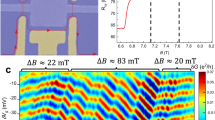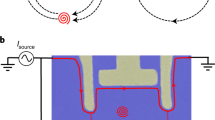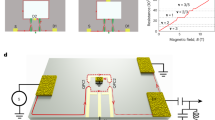Abstract
The braiding statistics of certain fractional quantum Hall states can be probed via interferometry of their edge states. Practical difficulties—including loss of phase coherence—make this a challenging task. We demonstrate the operation of a small Fabry–Perot interferometer in which highly coherent Aharonov–Bohm oscillations are observed in the integer and fractional quantum Hall regimes. Careful design of the heterostructure suppresses Coulomb effects and promotes strong phase coherence. We characterize the coherency of edge-mode interference by the energy scale for thermal damping and determine the velocities of the inner and outer edge modes independently via selective backscattering of edge modes originating in the N = 0, 1, 2 Landau levels. We also observe clear Aharonov–Bohm oscillations at fractional filling factors ν = 2/3 and ν = 1/3, which indicates that our device architecture provides a platform for measurement of anyonic braiding statistics.
This is a preview of subscription content, access via your institution
Access options
Access Nature and 54 other Nature Portfolio journals
Get Nature+, our best-value online-access subscription
$29.99 / 30 days
cancel any time
Subscribe to this journal
Receive 12 print issues and online access
$209.00 per year
only $17.42 per issue
Buy this article
- Purchase on Springer Link
- Instant access to full article PDF
Prices may be subject to local taxes which are calculated during checkout






Similar content being viewed by others
Data availability
The data that support the plots within this paper and other findings of this study are available from the corresponding author upon reasonable request.
References
Jain, J. K. Composite Fermions (Cambridge Univ. Press, Cambridge, 2007).
Chamon, C. et al. Two point-contact interferometer for quantum Hall systems. Phys. Rev. B 55, 2331–2343 (1997).
Sarma, S. D., Freedman, M. & Nayak, C. Topologically protected qubits from a possible non-Abelian fractional quantum Hall state. Phys. Rev. Lett. 94, 166802 (2005).
Stern, A. & Halperin, B. I. Proposed experiments to probe the non-Abelian ν = 5/2 quantum Hall state. Phys. Rev. Lett. 96, 016802 (2006).
Kim, E. Aharonov–Bohm interference and fractional statistics in a quantum Hall interferometer. Phys. Rev. Lett. 97, 216404 (2006).
Halperin, B. I. Statistics of quasiparticles and the hierarchy of fractional quantized Hall states. Phys. Rev. Lett. 52, 1583–1586 (1984).
Zhang, Y. et al. Distinct signatures for Coulomb blockade and interference in electronic Fabry–Perot interferometers. Phys. Rev. B 79, 241304(R) (2009).
Lin, P. V., Camino, F. E. & Goldman, V. J. Electron interferometry in the quantum Hall regime: Aharonov–Bohm effect of interacting electrons. Phys. Rev. B 80, 125310 (2009).
Baer, S. et al. Cyclic depopulation of edge states in a large quantum dot. New J. Phys. 15, 023035 (2013).
Ofek, N. et al. Role of interactions in an electron Fabry–Perot interferometer operating in the quantum Hall effect regime. Proc. Natl Acad. Sci. USA 107, 5276–5281 (2010).
Halperin, B. I. & Rosenow, B. Influence of interactions on flux and back-gate period of quantum Hall interferometers. Phys. Rev. Lett. 98, 106801 (2007).
Halperin, B. I., Stern, A., Neder, I. & Rosenow, B. Theory of the Fabry–Perot quantum Hall interferometer. Phys. Rev. B 83, 155440 (2011).
von Keyserlingk, C. W., Simon, S. H. & Rosenow, B. Enhanced bulk–edge Coulomb coupling in fractional Fabry–Perot interferometers. Phys. Rev. Lett. 115, 126807 (2015).
Manfra, M. J. Molecular beam epitaxy of ultra-high-quality AlGaAs/GaAs heterostructures: enabling physics in low-dimensional electronic systems. Annu. Rev. Condens. Matter Phys. 5, 347–373 (2014).
Gardner, G. C., Fallahi, S., Watson, J. D. & Manfra, M. J. Modified MBE hardware and techniques and role of gallium purity for attainment of two dimensional electron gas mobility >35 × 106 cm2/Vs in AlGaAs/GaAs quantum wells grown by MBE. J. Cryst. Growth 441, 71–77 (2016).
Sahasrabudhe, H. et al. Optimization of edge state velocity in the integer quantum Hall regime. Phys. Rev. B 97, 085302 (2018).
Eisenstein, J. P., Pfeiffer, L. N. & West, K. W. Independently contacted two-dimensional electron systems in double quantum wells. Appl. Phys. Lett. 57, 2324–2326 (1990).
Beenakker, C. W. J. Theory of Coulomb-blockade oscillations in the conductance of a quantum dot. Phys. Rev. B 44, 1646–1656 (1991).
McClure, D. T. Interferometer based studies of quantum Hall phenomena. PhD thesis, Harvard Univ. (2012).
Roulleau, P. et al. Direct measurement of the coherence length of edge states in the integer quantum Hall regime. Phys. Rev. Lett. 100, 126802 (2008).
McClure, D. T. et al. Edge-state velocity and coherence in a quantum Hall Fabry–Perot interferometer. Phys. Rev. Lett. 103, 206806 (2009).
Gurman, I., Sabo, R., Heiblum, M., Umansky, V. & Mahalu, D. Dephasing of an electronic two-path interferometer. Phys. Rev. B 93, 121412 (R) (2016).
Choi, H. K. et al. Robust electron pairing in the integer quantum Hall effect. Nat. Commun. 6, 7435 (2015).
Sivan, I. et al. Interaction-induced interference in the integer quantum Hall effect. Phys. Rev. B 97, 125405 (2018).
Frigeri, G. A., Scherer, D. D. & Rosenow, B. Subperiods and apparent pairing in integer quantum Hall interferometers. Preprint at https://arxiv.org/abs/1709.04504 (2017).
Chklovskii, D. B., Shklovskii, B. I. & Glazman, L. I. Electrostatics of edge channels. Phys. Rev. B 46, 4026–4034 (1992).
Chklovskii, D. B., Matveev, K. A. & Shklovskii, B. I. Ballistic conductance of interacting electrons in the quantum Hall regime. Phys. Rev. B 47, 12605–12617 (1993).
Montambaux, G. Semiclassical quantization of skipping orbits. Eur. Phys. J. B 79, 215–224 (2011).
McClure, D. T., Chang, W., Marcus, C. M., Pfeiffer, L. N. & West, K. W. Fabry–Perot interferometry with fractional charges. Phys. Rev. Lett. 108, 256804 (2012).
Camino, F. E., Zhou, W. & Goldman, V. J. Aharonov–Bohm superperiod in a Laughlin quasiparticle interferometer. Phys. Rev. Lett. 95, 246802 (2005).
Camino, F. E., Zhou, W. & Goldman, V. J. e/3 Laughlin quasiparticle primary-filling ν = 1/3 interferometer. Phys. Rev. Lett. 98, 076805 (2007).
Willett, R. L., Pfeiffer, L. N. & West, K. W. Measurement of filling factor 5/2 quasiparticle interference with observation of charge e/4 and e/2 period oscillations. Proc. Natl Acad. Sci. USA 106, 8853–8858 (2009).
Willett, R. L., Nayak, C., Shtengel, K., Pfeiffer, L. N. & West, K. W. Magnetic-field-tuned Aharonov–Bohm oscillations and evidence for non-Abelian anyons at ν = 5/2. Phys. Rev. Lett. 111, 186401 (2013).
Laughlin, R. B. Anomalous quantum Hall effect: an incompressible quantum fluid with fractionally charged excitation. Phys. Rev. Lett. 50, 1395–1398 (1983).
Jain, J. K. Composite-fermion approach for the fractional quantum Hall effect. Phys. Rev. Lett. 63, 199–202 (1989).
de-Picciotto, R. et al. Direct observation of a fractional charge. Nature 389, 162–164 (1997).
Goldman, V. J. Resonant tunneling in the quantum Hall regime: measurement of fractional charge. Science 267, 1010–1012 (1995).
Goldman, V. J. Resonant tunneling in the quantum Hall regime: measurement of fractional charge. Surf. Sci. 361/362, 1–6 (1995).
Girvin, S. M. Particle–hole symmetry in the anomalous quantum Hall effect. Phys. Rev. B 29, 6012–6014 (1984).
MacDonald, A. H. Edge states in the fractional-quantum-Hall-effect regime. Phys. Rev. Lett. 64, 220–223 (1990).
Chang, A. M. A unified transport theory for the integral and fractional quantum Hall effects: phase boundaries, edge currents, and transmission/reflection probabilities. Solid State Commun. 74, 871–876 (1990).
Beenakker, C. W. J. Edge channels for the fractional quantum Hall effect. Phys. Rev. Lett. 64, 216–219 (1990).
Meir, Y. Composite edge states in the ν = 2/3 fractional quantum Hall regime. Phys. Rev. Lett. 72, 2624–2627 (1993).
Kane, C. L., Fisher, M. P. A. & Polchinski, J. Randomness at the edge: theory of quantum Hall transport at filling ν = 2/3. Phys. Rev. Lett. 72, 4129–4132 (1994).
Bid, A., Ofek, N., Heiblum, M., Umansky, V. & Mahalu, D. Shot noise and charge at the 2/3 composite fractional quantum Hall state. Phys. Rev. Lett. 103, 236802 (2009).
Sabo, R. et al. Edge reconstruction in fractional quantum Hall states. Nat. Phys. 13, 491–496 (2017).
Hu, Z., Rezayi, E. H., Wan, X. & Yang, K. Edge-mode velocities and thermal coherence of quantum Hall interferometers. Phys. Rev. B 80, 235330 (2009).
Wan, X., Yang, K. & Rezayi, E. H. Reconstruction of fractional quantum Hall edges. Phys. Rev. Lett. 88, 056802 (2002).
Joglekar, Y. N., Nguyen, H. K. & Murthy, G. Edge reconstructions in fractional quantum Hall systems. Phys. Rev. B 68, 035332 (2003).
Goldsten, M. & Gefen, Y. Suppression of interference in quantum Hall Mach–Zehnder geometry by upstream neutral modes. Phys. Rev. Lett. 117, 276804 (2016).
Park, J., Gefen, Y. & Sim, H. Topological dephasing in the ν = 2/3 fractional quantum Hall regime. Phys. Rev. B 92, 245437 (2015).
Inoue, H. et al. Proliferation of neutral modes in fractional quantum Hall states. Nat. Commun. 5, 4067 (2014).
Du, R. R., Stormer, H. L., Tsui, D. C., Pfeiffer, L. N. & West, K. W. Experimental evidence for new particles in the fractional quantum Hall effect. Phys. Rev. Lett. 70, 2944–2947 (1993).
Acknowledgements
This work was supported by the Department of Energy, Office of Basic Energy Sciences, under award number DE-SC0006671. Additional support for sample growth from the W. M. Keck Foundation and Nokia Bell Labs is gratefully acknowledged. We thank M. Heiblum, R. L. Willett and S. H. Simon for helpful comments that improved our manuscript.
Author information
Authors and Affiliations
Contributions
J.N. and M.J.M. designed the heterostructures and experiments. S.F., S.L. and G.C.G. conducted molecular beam epitaxy growth. J.N. fabricated the devices, performed the measurements and analysed the data with input from M.J.M. H.S. and R.R. performed numerical simulations. J.N. and M.M. wrote the manuscript with input from all authors.
Corresponding author
Ethics declarations
Competing interests
The authors declare no competing interests.
Additional information
Journal peer review information: Nature Physics thanks Thomas Ihn and the other anonymous reviewer(s) for their contribution to the peer review of this work.
Publisher’s note: Springer Nature remains neutral with regard to jurisdictional claims in published maps and institutional affiliations.
Supplementary information
Supplementary Information
Supplementary Figures 1–8 and Supplementary References 1–6.
Rights and permissions
About this article
Cite this article
Nakamura, J., Fallahi, S., Sahasrabudhe, H. et al. Aharonov–Bohm interference of fractional quantum Hall edge modes. Nat. Phys. 15, 563–569 (2019). https://doi.org/10.1038/s41567-019-0441-8
Received:
Accepted:
Published:
Issue Date:
DOI: https://doi.org/10.1038/s41567-019-0441-8
This article is cited by
-
Anyonic interference and braiding phase in a Mach-Zehnder interferometer
Nature Physics (2023)
-
Observation of ballistic upstream modes at fractional quantum Hall edges of graphene
Nature Communications (2022)
-
Impact of bulk-edge coupling on observation of anyonic braiding statistics in quantum Hall interferometers
Nature Communications (2022)
-
Upstream modes and antidots poison graphene quantum Hall effect
Nature Communications (2021)
-
Andreev reflection of fractional quantum Hall quasiparticles
Nature Communications (2021)



